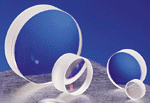|
Optical
Specifications
Optical
Materials
Achromatic
Lenses
Spherical
Lenses
Cylindrical
Lenses
Prisms
Penta
Prisms
Corner
Cube Retroreflector
Waveplate
Beamsplitters
Filters
Coating
Cleaning
Optics
|
|
Achromats
Lens
|
|
The
optical performance of compound lenses, two or more single
elements designed to work together, is superior to that of
single lens elements working alone. Achromatic doublets and
triplets are compound lenses composed of two and three singlets.
Designers often abbreviate their reference to achromatic doublets
and triplets by simply calling them achromats.
|
 |
|
The
origin of the technical term "achromatic" is in
the color-corrected performance of compound lenses. They are
designed to outperform singlets by all measures, but designers
give special attention to the reduction of color effects in
their images. "Achromatic" literally means "without
color," and in lens design, the term refers to minimal
difference of focal length between two specific wavelengths.
|
|
Achromats
are the simplest of the multi-element or compound lens designs.
Aberrations inherent in a single lens element limit imaging
performance. By carefully combining complementary singlets
and assembling them into a compound lens, designers can reduce
the net aberration of the image. Aberrations induced by one
singlet can be cancelled by the opposing aberrations of other
singlets.
|
|
Achromatic
doublets generally demonstrate these principles: one element
is made of crown glass (low refractive index and low dispersion);
the other is made of flint glass (high refractive index and
high dispersion).
The ultimate quality
of an image often can be related to the number of elements
within the lens. A rule of thumb states, "The more elements,
the better the quality." This rule is usually valid because
more elements give the designer more degrees of freedom to
control aberrations in the image.
Achromatic doublets
and triplets deliver about the same image quality; the advantage
of the triplet over the doublet lies in its ability to work
at lower f-numbers (higher speed) and larger fields of view.
|
|
Achromats,
a class of lenses whose image quality is superior to that
of singlets, include cemented doublets, air-spaced doublets
and cemented triplets. Improved performance is achieved with
the two different kinds of glass. Multiple elements provide
added degrees of freedom for the designer to balance aberrations
near the optical axis. Achromats are useful in applications
requiring a lens with a narrow field of view and large to
moderately small f-numbers.
The difference
between achromatic triplets and doublets is small. Sometimes
the slightly lower f-number or slightly larger field of view
of a cemented triplet makes it a better candidate for an application
than a cemented doublet. In addition, the symmetrical construction
of most cemented triplets enhances performance for 1:1 imaging.
|
|
